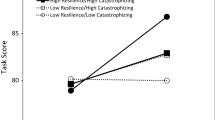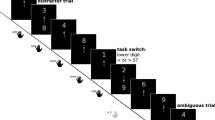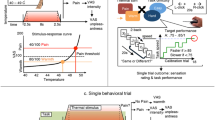Abstract
The Pain Resilience Scale was recently developed to assess dimensions of resilience critical to pain-related adaptation and was found to predict experimental pain sensitivity in a pain-free population. Pain resilience has also been theoretically linked to behavioral persistence despite pain. To date, however, this hypothesis has not been experimentally tested. To address this gap in the literature, in the current study 105 healthy young adults underwent a baseline administration of the Paced Auditory Serial Addition Test (PASAT), a stressful mental arithmetic task, delivered with somatosensory distraction (i.e. detection of warm and cool thresholds), and finally simultaneous administration of the PASAT and a series of five heat pain threshold assessments. Results of hierarchical multiple linear regressions indicated that, after controlling for scores on a baseline PASAT and pain sensitivity, pain resilience was positively related to task persistence, B = 0.12, p = 0.04, and task performance, B = 0.14, p = 0.04, on the PASAT. These findings provide novel support for the relationship between pain resilience and behavioral perseverance.

Similar content being viewed by others
References
Bate, A. J., Mathias, J. L., & Crawford, J. R. (2001). Performance on the Test of Everyday Attention and standard tests of attention following severe traumatic brain injury. The Clinical Neuropsychologist, 15, 405–422.
Bodde, M. I., Schrier, E., Krans, H. K., Geertzen, J. H., & Dijkstra, P. U. (2013). Resilience in patients with amputation because of Complex Regional Pain Syndrome type I. Disability and Rehabilitation, 36, 838–843.
Boselie, J. J., Vancleef, L. M., Smeets, T., & Peters, M. L. (2014). Increasing optimism abolishes pain-induced impairments in executive task performance. Pain, 155, 334–340.
Buhle, J., & Wager, T. D. (2010). Performance-dependent inhibition of pain by an executive working memory task. Pain, 149, 19–26.
Crawford, J. R., Obonsawin, M. C., & Allan, K. M. (1998). PASAT and components of WAIS-R performance: Convergent and discriminant validity. Neuropsychological Rehabilitation, 8, 255–272.
Daughters, S. B., Lejuez, C. W., Kahler, C. W., Strong, D. R., & Brown, R. A. (2005). Psychological distress tolerance and duration of most recent abstinence attempt among residential treatment-seeking substance abusers. Psychology of Addictive Behaviors, 19, 208.
Erpelding, N., & Davis, K. D. (2013). Neural underpinnings of behavioural strategies that prioritize either cognitive task performance or pain. Pain, 154, 2060–2071.
Friborg, O., Hjemdal, O., Rosenvinge, J. H., Martinussen, M., Aslaksen, P. M., & Flaten, M. A. (2006). Resilience as a moderator of pain and stress. Journal of Psychosomatic Research, 61, 213–219.
Gatchel, R. J., Peng, Y. B., Peters, M. L., Fuchs, P. N., & Turk, D. C. (2007). The biopsychosocial approach to chronic pain: Scientific advances and future directions. Psychological Bulletin, 133, 581–624.
George, S. Z., Valencia, C., & Beneciuk, J. M. (2010). A psychometric investigation of fear-avoidance model measures in patients with chronic low back pain. Journal of Orthopaedic and Sports Physical Therapy, 40, 197–205.
Gronwall, D. M. (1977). Paced auditory serial-addition task: A measure of recovery from concussion. Perceptual and Motor Skills, 44, 367–373.
Holdwick, D. J., & Wingenfeld, S. A. (1999). The subjective experience of PASAT testing: Does the PASAT induce negative mood? Archives of Clinical Neuropsychology, 14, 273–284.
Hood, A., Pulvers, K., Carrillo, J., Merchant, G., & Thomas, M. (2012). positive traits linked to less pain through lower pain catastrophizing. Personality and Individual Differences, 52, 401–405.
Karsdorp, P. A., Ranson, S., Schrooten, M. G., & Vlaeyen, J. W. (2012). Pain catastrophizing, threat, and the informational value of mood: Task persistence during a painful finger pressing task. Pain, 153, 1410–1417.
Kilic, S. A., Dorstyn, D. S., & Guiver, N. G. (2013). Examining factors that contribute to the process of resilience following spinal cord injury. Spinal Cord, 51, 553–557.
Lü, W., Wang, Z., & You, X. (2016). Physiological responses to repeated stress in individuals with high and low trait resilience. Biological Psychology, 120, 46–52.
Min, J. A., Lee, C. U., Hwang, S. I., Shin, J. I., Lee, B. S., Han, S. H., et al. (2013). The moderation of resilience on the negative effect of pain on depression and post-traumatic growth in individuals with spinal cord injury. Disability and Rehabilitation, 36, 1196–2002.
Moore, D. J., Keogh, E., & Eccleston, C. (2012). The interruptive effect of pain on attention. The Quarterly Journal of Experimental Psychology (Hove), 65, 565–586.
Ong, A. D., Zautra, A. J., & Reid, M. C. (2010). Psychological resilience predicts decreases in pain catastrophizing through positive emotions. Psychology and Aging, 25, 516–523.
Quartana, P. J., Campbell, C. M., & Edwards, R. R. (2009). Pain catastrophizing: A critical review. Expert Review of Neurotherapeutics, 9, 745–758.
Seminowicz, D. A., Mikulis, D. J., & Davis, K. D. (2004). Cognitive modulation of pain-related brain responses depends on behavioral strategy. Pain, 112, 48–58.
Slepian, P. M., Ankawi, B., Himawan, L. K., & France, C. R. (2016). Development and initial validation of the pain resilience scale. The Journal of Pain, 17, 462–472.
Smith, B. W., Tooley, E. M., Montague, E. Q., Robinson, A. E., Cosper, C. J., & Mullins, P. G. (2009). The role of resilience and purpose in life in habituation to heat and cold pain. The Journal of Pain, 10, 493–500.
Solberg Nes, L., Carlson, C. R., Crofford, L. J., de Leeuw, R., & Segerstrom, S. C. (2010). Self-regulatory deficits in fibromyalgia and temporomandibular disorders. Pain, 151, 37–44.
Solberg Nes, L., Roach, A. R., & Segerstrom, S. C. (2009). Executive functions, self-regulation, and chronic pain: A review. Annals of Behavioral Medicine, 37, 173–183.
Souza, G. G., Magalhaes, L. N., Cruz, T. A., Mendonca-De-Souza, A. C., Duarte, A. F., Fischer, N. L., et al. (2013). Resting vagal control and resilience as predictors of cardiovascular allostasis in peacekeepers. Stress, 16, 377–383.
Sturgeon, J. A., & Zautra, A. J. (2010). Resilience: A new paradigm for adaptation to chronic pain. Current Pain and Headache Reports, 14, 105–112.
Sturgeon, J. A., & Zautra, A. J. (2013). Psychological resilience, pain catastrophizing, and positive emotions: Perspectives on comprehensive modeling of individual pain adaptation. Current Pain and Headache Reports, 17, 317.
Sullivan, M. J. L., Bishop, S., & Pivik, J. (1995). The Pain Catastrophizing Scale: Development and validation. Psychological Assessment, 7, 524–532.
Sullivan, M. J., Thorn, B., Haythornthwaite, J. A., Keefe, F., Martin, M., Bradley, L. A., et al. (2001). Theoretical perspectives on the relation between catastrophizing and pain. Clinical Journal of Pain, 17, 52–64.
Szasz, P. L., Szentagotai, A., & Hofmann, S. G. (2012). Effects of emotion regulation strategies on smoking craving, attentional bias, and task persistence. Behaviour Research and Therapy, 50, 333–340.
Tombaugh, T. N. (2006). A comprehensive review of the paced auditory serial addition test (PASAT). Archives of Clinical Neuropsychology, 21, 53–76.
Viggers, L. C., & Caltabiano, M. L. (2012). Factors affecting the psychological functioning of Australian adults with chronic pain. Nursing and Health Sciences, 14, 508–513.
Wideman, T. H., Asmundson, G. G., Smeets, R. J., Zautra, A. J., Simmonds, M. J., Sullivan, M. J., et al. (2013). Rethinking the fear avoidance model: Toward a multidimensional framework of pain-related disability. Pain, 154, 2262–2265.
Woolf, C. J., & Ma, Q. (2007). Nociceptors–noxious stimulus detectors. Neuron, 55, 353–364.
Author information
Authors and Affiliations
Corresponding author
Ethics declarations
Conflict of interest
P. Maxwell Slepian and Christopher R. France declare that they do not have any conflict of interest.
Human and animal rights and Informed consent
All procedures followed were in accordance with ethical standards of the responsible committee on human experimentation (institutional and national) and with the Helsinki Declaration of 1975, as revised in 2000. Informed consent was obtained from all patients for being included in the study.
Rights and permissions
About this article
Cite this article
Slepian, P.M., France, C.R. The effect of resilience on task persistence and performance during repeated exposure to heat pain. J Behav Med 40, 894–901 (2017). https://doi.org/10.1007/s10865-017-9854-y
Received:
Accepted:
Published:
Issue Date:
DOI: https://doi.org/10.1007/s10865-017-9854-y




